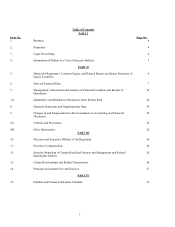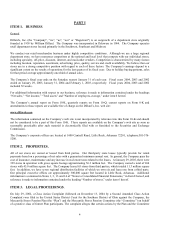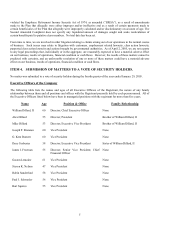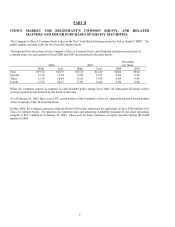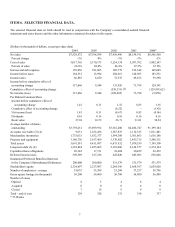Dillard's 2004 Annual Report Download - page 16
Download and view the complete annual report
Please find page 16 of the 2004 Dillard's annual report below. You can navigate through the pages in the report by either clicking on the pages listed below, or by using the keyword search tool below to find specific information within the annual report.and the corresponding month for the prior year. Non-comparable store sales include sales in the current fiscal year from
stores opened during the previous fiscal year before they are considered comparable stores, sales from new stores opened
in the current fiscal year and sales in the previous fiscal year for stores that were closed in the current fiscal year.
Service Charges, Interest and Other Income. Service Charges, Interest and Other Income include interest and service
charges, net of service charge write-offs, related to the Company’s proprietary credit card sales. Other income relates to
joint ventures accounted for by the equity method, rental income, shipping and handling fees and gains (losses) on the
sale of property and equipment and joint ventures. Other income also includes income generated through the long-term
marketing and servicing alliance between the Company and GE and the resulting gain on the sale of its credit card
business to GE.
Cost of Sales. Cost of sales includes the cost of merchandise sold net of purchase discounts, bankcard fees, freight to the
distribution centers, employee and promotional discounts, non-specific vendor allowances and direct payroll for salon
personnel.
Advertising, selling, administrative and general expenses. Advertising, selling, administrative and general expenses
include buying, occupancy, selling, distribution, warehousing, store and corporate expenses (including payroll and
employee benefits), insurance, employment taxes, advertising, management information systems, legal, bad debt costs
and other corporate level expenses. Buying expenses consist of payroll, employee benefits and travel for design, buying
and merchandising personnel.
Depreciation and amortization. Depreciation and amortization expenses include depreciation and amortization on
property and equipment.
Rentals. Rentals include expenses for store leases and data processing equipment rentals.
Interest and debt expense. Interest and debt expense includes interest relating to the Company’s unsecured notes,
mortgage notes, credit card receivables financing, the Guaranteed Beneficial Interests in the Company’s subordinated
debentures, gains and losses on note repurchases, amortization of financing costs, call premiums and interest on capital
lease obligations.
Asset impairment and store closing charges. Asset impairment and store closing charges consist of write-downs to
fair value of under-performing properties and exit costs associated with the closure of certain stores. Exit costs include
future rent, taxes and common area maintenance expenses from the time the stores are closed.
Cumulative effect of accounting change. Effective February 3, 2002, the Company adopted Statement of Financial
Accounting Standards (“SFAS”) No. 142, “Goodwill and Other Intangible Assets”. SFAS No. 142 changes the
accounting for goodwill from an amortization method to an “impairment only” approach. Under SFAS No. 142,
goodwill is no longer amortized but reviewed for impairment annually or more frequently if certain indicators arise. The
Company tested goodwill for impairment as of the adoption date using the two-step process prescribed in SFAS No. 142.
The Company identified its reporting units under SFAS No. 142 at the store unit level. The fair value of these reporting
units was estimated using the expected discounted future cash flows and market values of related businesses, where
appropriate. The cumulative effect of the accounting change as of February 3, 2002 was to decrease net income for fiscal
year 2002 by $530 million or $6.22 per diluted share.
Critical Accounting Policies and Estimates
The Company’s accounting policies are more fully described in Note 1 of Notes to Consolidated Financial Statements.
As disclosed in Note 1 of Notes to Consolidated Financial Statements, the preparation of financial statements in
conformity with accounting principles generally accepted in the United States of America (“GAAP”) requires
management to make estimates and assumptions about future events that affect the amounts reported in the consolidated
financial statements and accompanying notes. Since future events and their effects cannot be determined with absolute
certainty, actual results will differ from those estimates. The Company evaluates its estimates and judgments on an
ongoing basis and predicates those estimates and judgments on historical experience and on various other factors that are
believed to be reasonable under the circumstances. Actual results will differ from these under different assumptions or
conditions.
12



